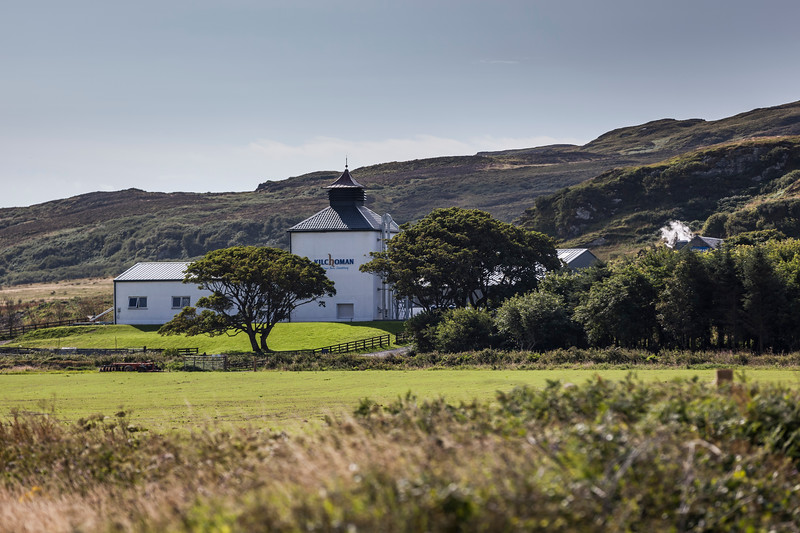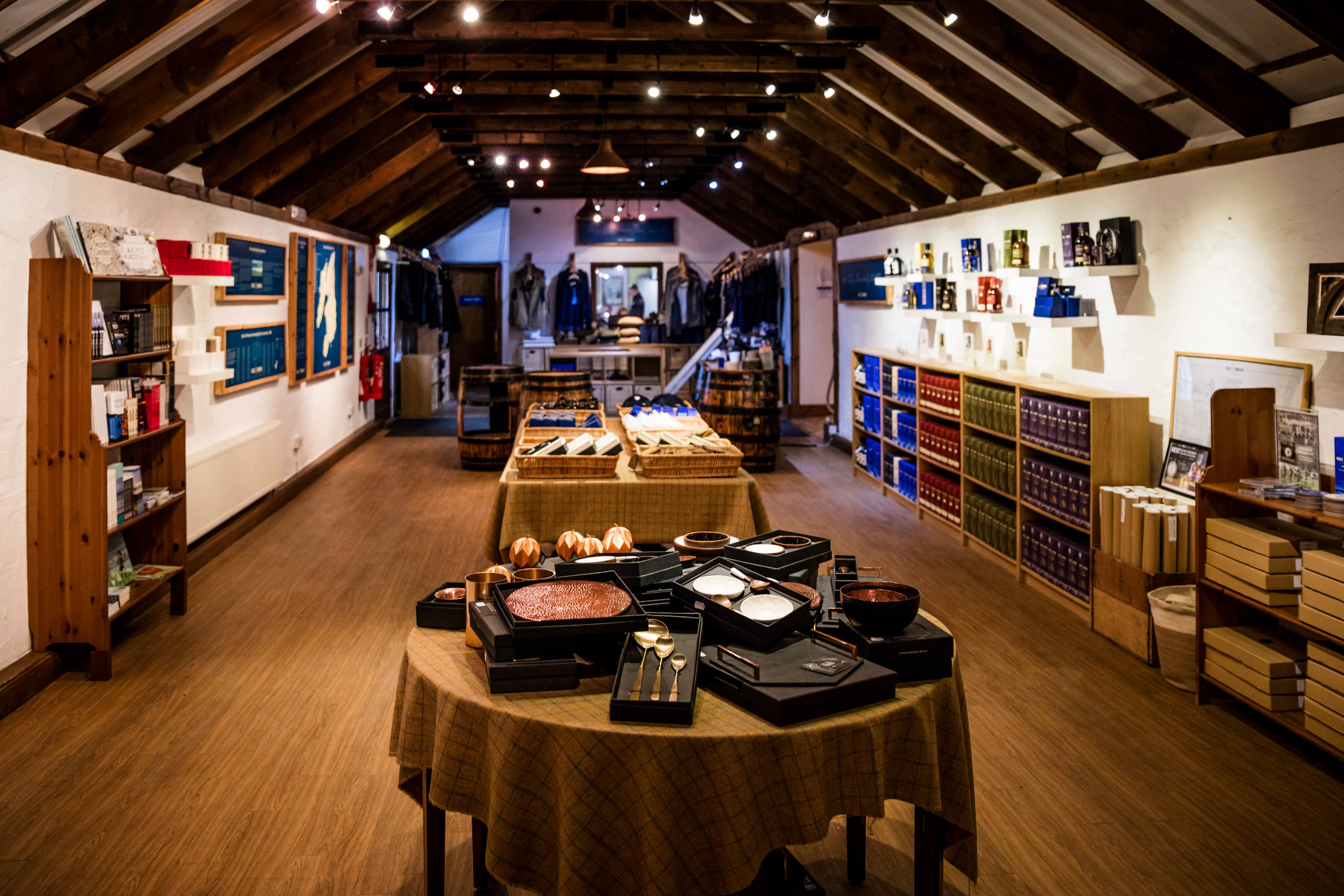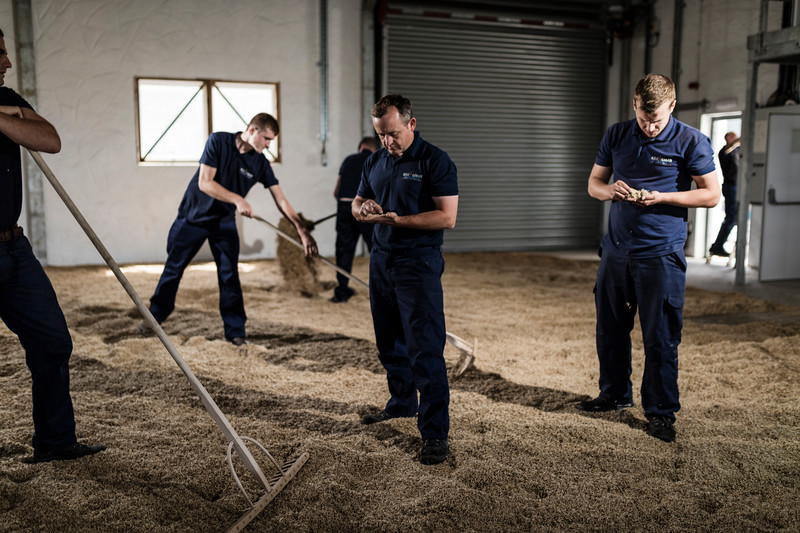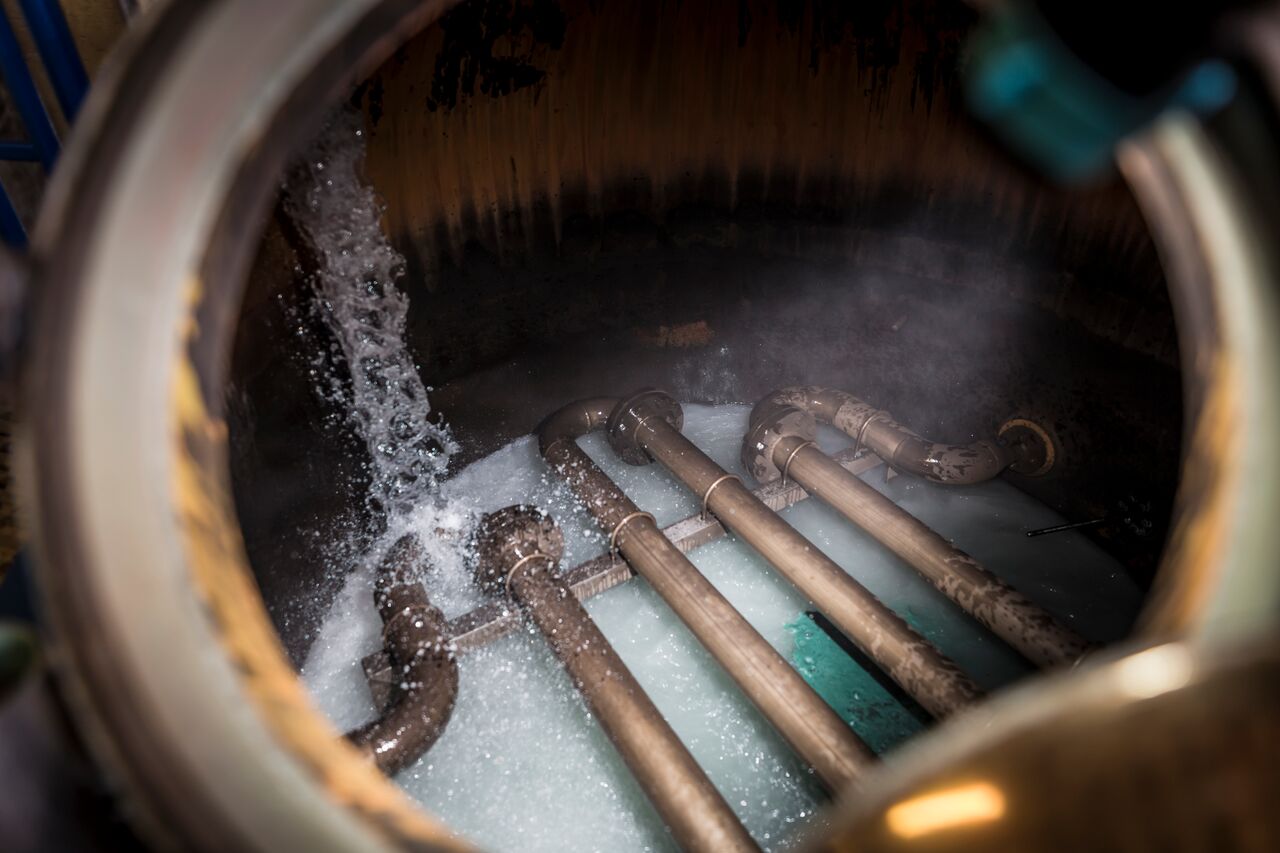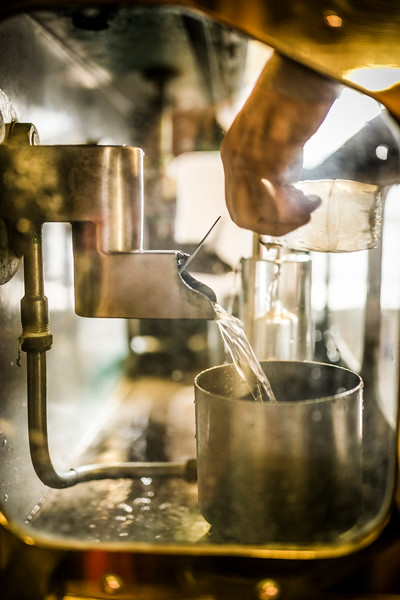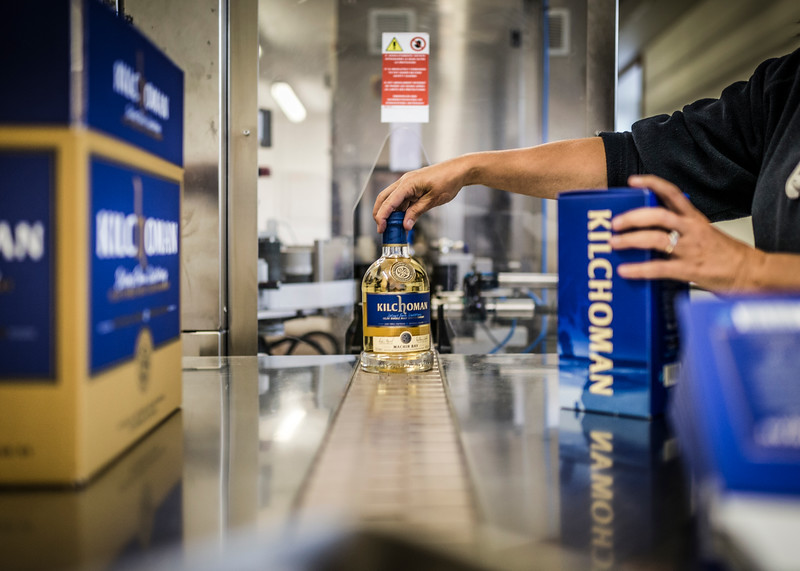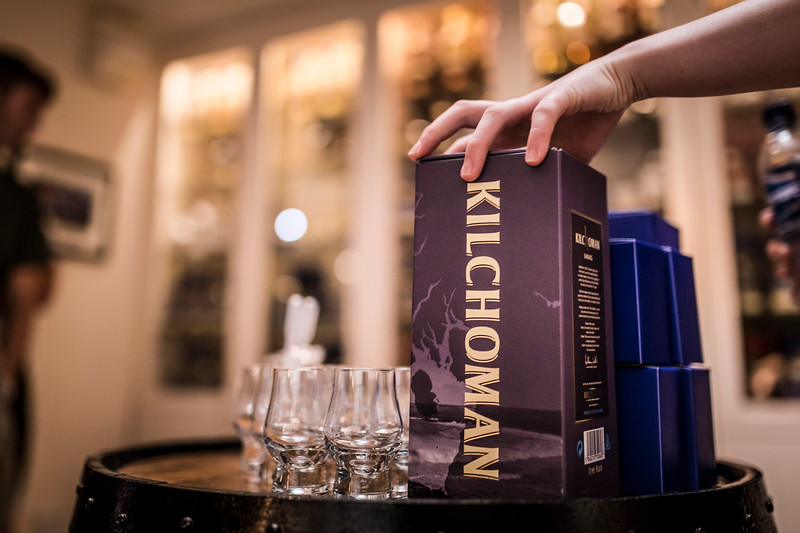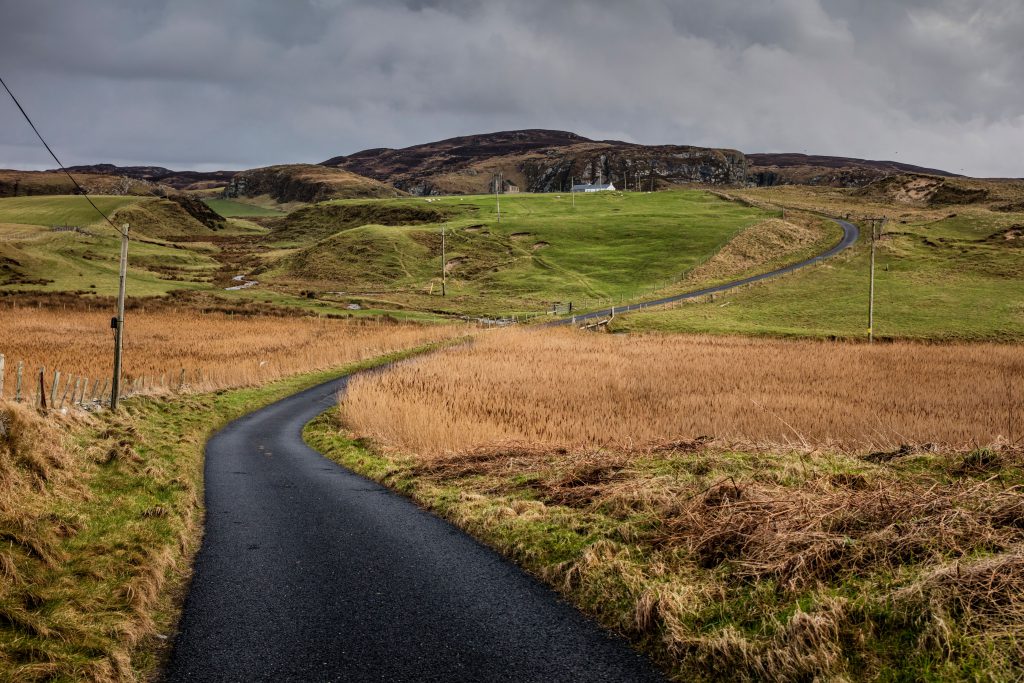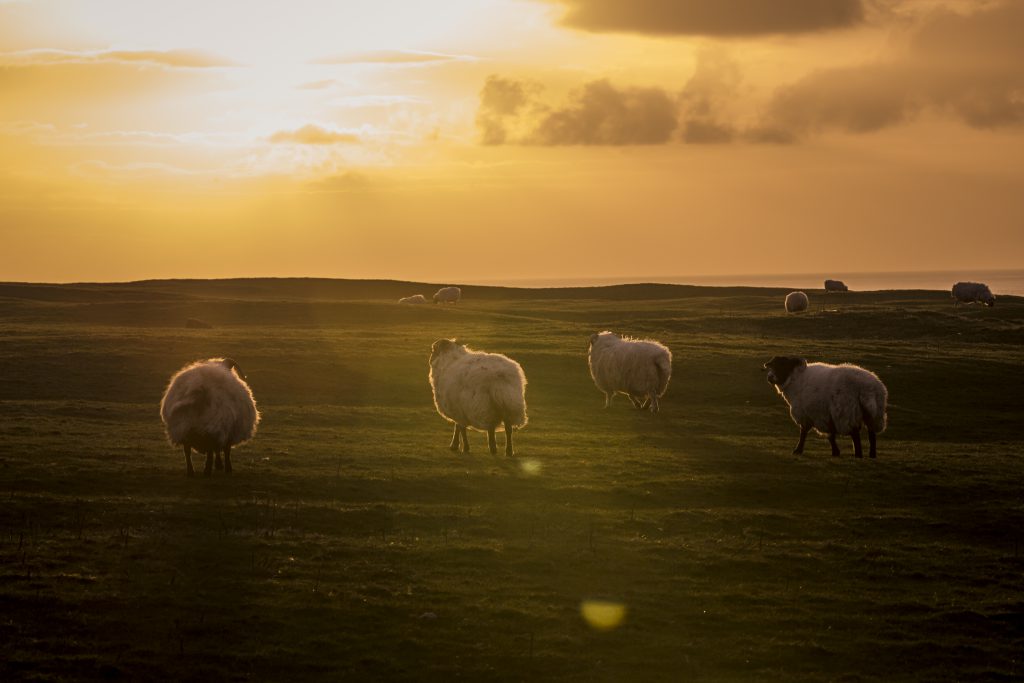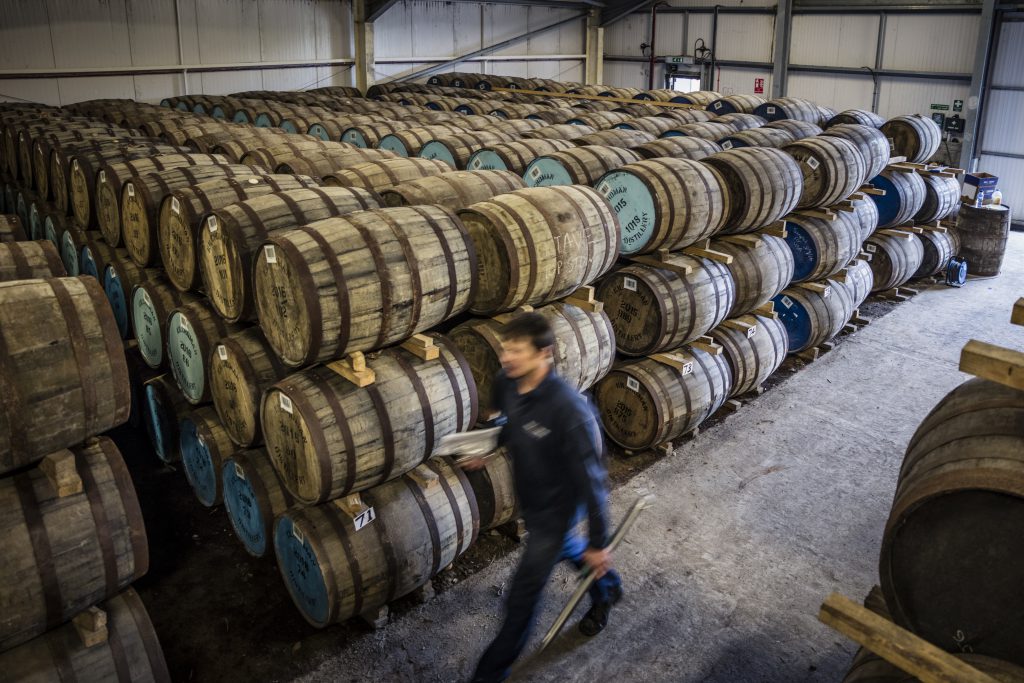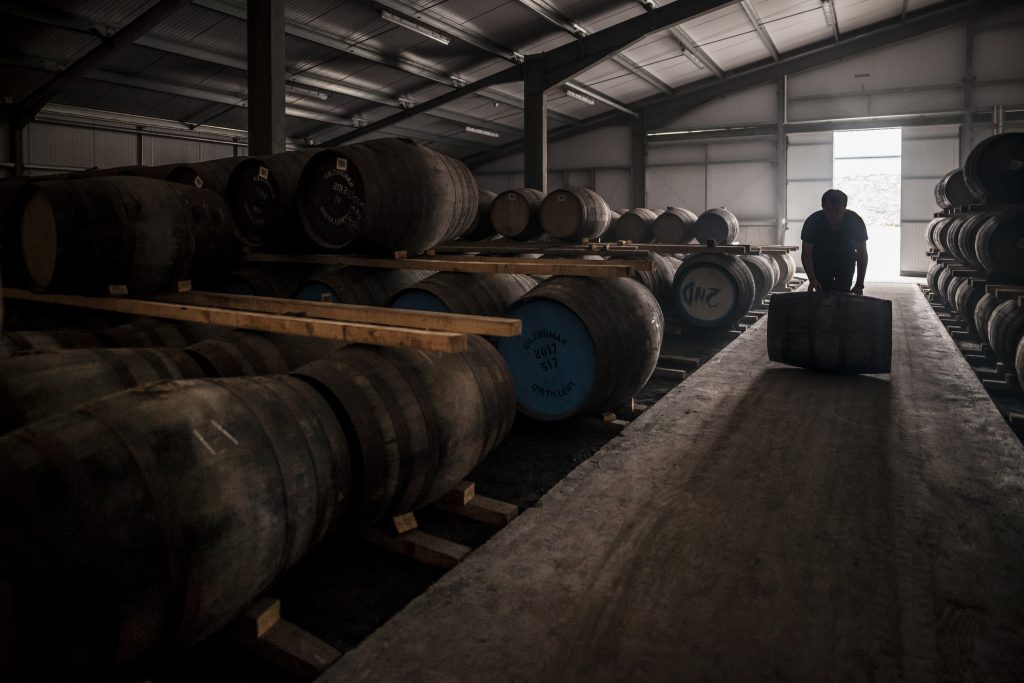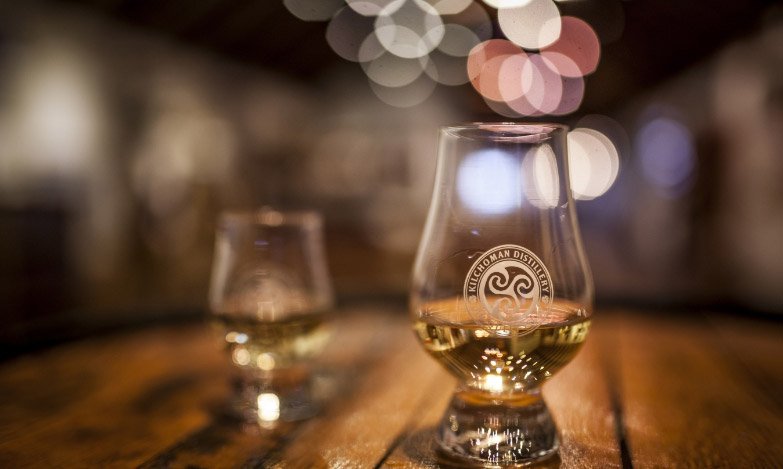The term PPM is a common one in the whisky industry and one associated particularly closely with Islay. The first question we are often asked when pouring a Kilchoman dram to visitors is ‘what is the ppm’. PPM (parts per million) is the measurement used to determine the phenol content of the malted barley after kilning and before being used in the rest of the whisky-making process.
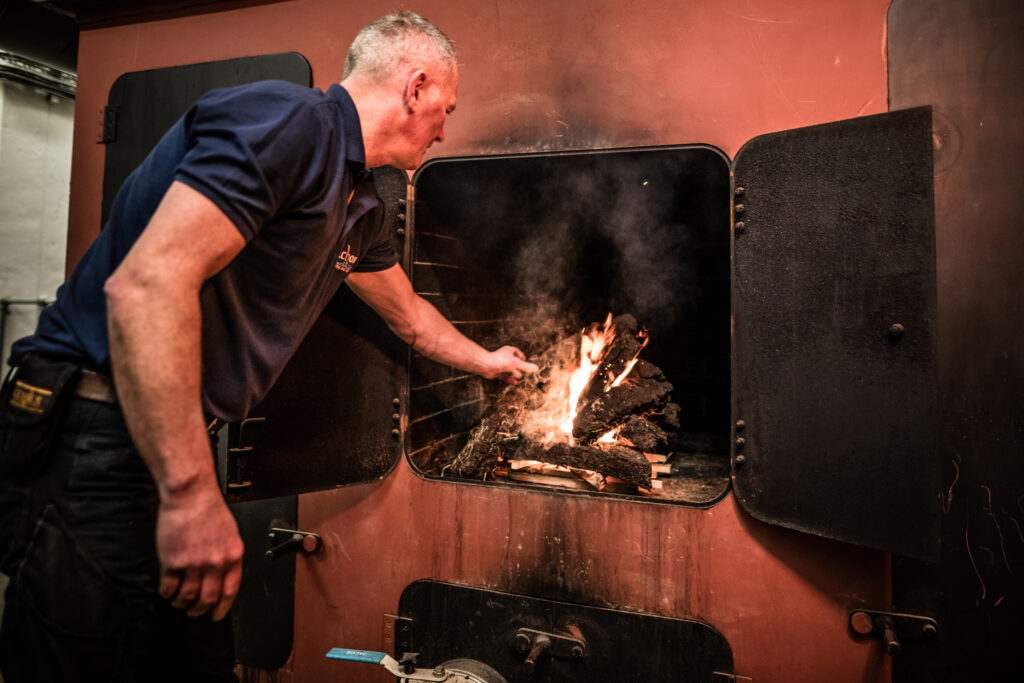
Peat is burnt in the kiln, releasing a group of compounds which are known as phenols, something we identify as smoke or peat character. These compounds in the smoke from the burnt peat rise up the kiln and attach themselves to the moist barley sitting on the kiln floor above. The longer the green malt is left in the kiln and exposed to the peat fire, the higher the phenol parts per million will be. We peat our malt for an average of 10 hours, giving the Kilchoman 100% Islay Single Farm Single Malt a phenol level of 20ppm. We also use a more heavily peated malt at 50ppm from Port Ellen maltings for other whiskies in the Kilchoman range, have a look at the full range here.
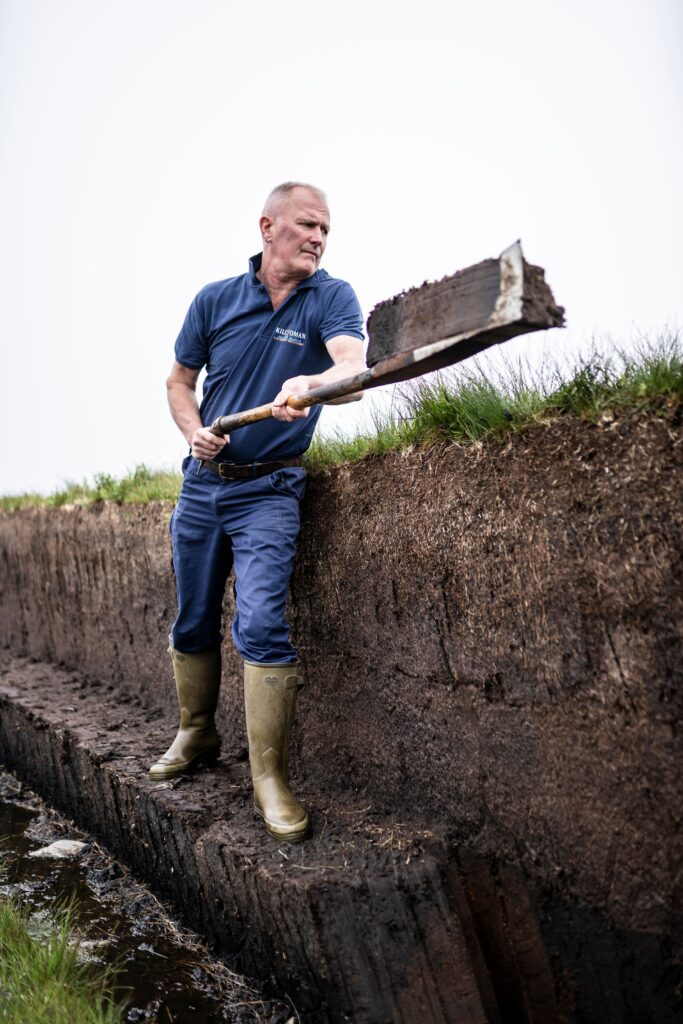
Although measuring the phenol ppm is an accurate representation of how heavily peated the malted barley is, the phenol level is then reduced throughout the rest of the whisky-making process. The mashing, fermentation, distillation and maturation all have impacts on the phenol level and how much smoke or peat you will taste in the final whisky.
The wide range of flavours in Scotch whisky is one of the many reasons it has become such a popular drink with so many passionate followers around the world. Each distillery can make subtle changes to their production to produce a vastly different style and character. All these variations affect the phenol ppm, for example, here at Kilchoman we have one of the longest fermentation times of 85 hours. This long fermentation adds layers of mixed fruits and depth of flavour which masks some of the high phenol ppm in the malted barley.
We also have some of the smallest stills in Scotland, exclusively designed for Kilchoman with a tall neck and reflux bulb, producing a pure and clean spirit. This combined with a high spirit cut point again reduces some of the phenol compounds from the malt. If starting from the same ppm levels in the malted barley, distilleries with shorter fermentation, lower cut points and larger stills would carry through higher ppm levels into the final spirit.
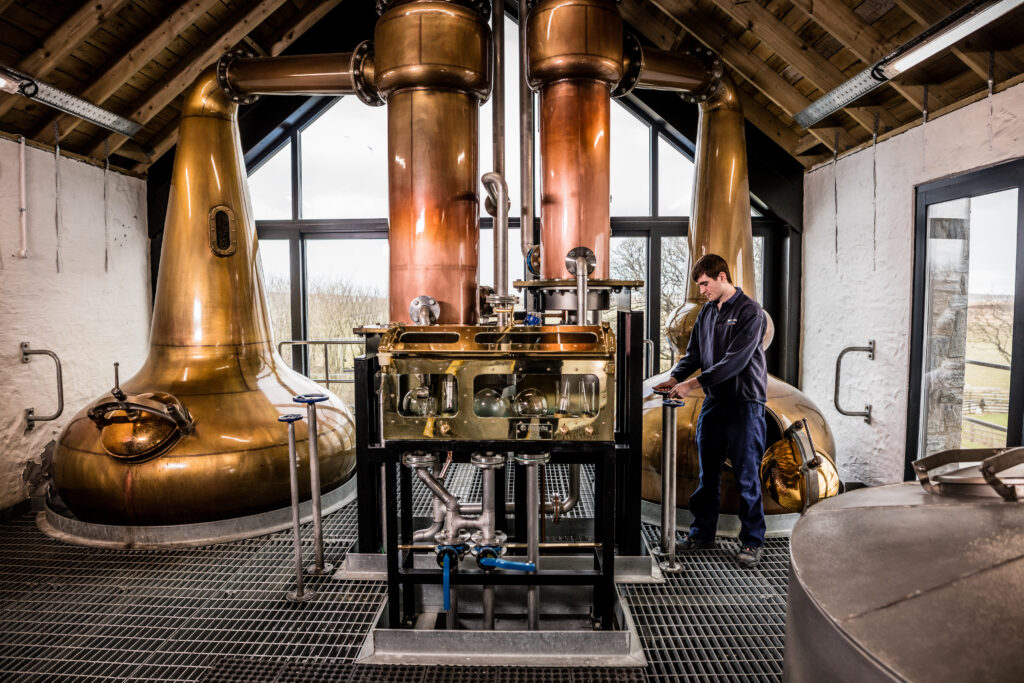
So, what is ppm… It is an accurate measurement of the phenol parts per million of malted barley, and very useful information when deciding on your next dram, however it is best used as a guide rather than a definitive analysis of how peaty the whisky will taste.
We’re sure you already know that all whisky isn’t the same. The intricate differences that exist from bottle to bottle give each type of whisky its own unique personality and flavour. In this guide, we will be outlining the key differences between scotch and bourbon, helping you fully appreciate the story behind your next dram.

Geography
The most obvious difference between scotch and bourbon is where they come from. Scotch, as you might have guessed, is made in Scotland. For example, Kilchoman Single Malt Whisky is a scotch whisky because it is made at our distillery on the Isle of Islay, Scotland. While this may appear obvious, it’s actually against the law to sell whisky that has not been produced in Scotland as scotch.

The origin of where bourbon takes its name from is more of a mystery. The most common answer is that bourbon takes its name from the county of Bourbon in Kentucky, where bourbon was first produced. Although, some believe its etymology can be traced back to the French bourbon dynasty.
During the late 18th century, Bourbon Louis XVI was the French king and the American War of Independence was in full swing. At the end of the war, Kentucky decided to name Bourbon county after the French king in gratitude of France’s allegiance to America against the British. A similar story exists for Bourbon Street in New Orleans, which was named after Louis XVI’s son, Bourbon Duke of Orleans. Therefore, it is hard to pinpoint where exactly the whiskey took its name from. One thing we do know for sure is that bourbon must be made in America to classify as bourbon.
Spelling
Have you ever wondered what the difference between the spelling “whisky” and “whiskey” means? Here’s why. Scotland and Ireland were the first countries to produce whisky. In fact, the word whisky comes from the Irish Gaelic ‘uisce beatha’ and the Scottish Gaelic equivalent ‘uisge-beatha’; both of which literally translate as ‘water of life’. During the 19th century, Irish distilleries decided that they didn’t want their whiskey to be associated with that of the Scots. At the time, Scottish whisky was not of the high quality it is today, and the Irish wanted to advertise that their whiskey was different. Therefore, they decided to change their spelling to include an additional ‘e’ to make it clear that their whiskey was Irish. Ireland and America use ‘whiskey’, while England, Scotland, Japan and India will use the Scottish spelling. As a result, scotch is “whisky” and bourbon is “whiskey”.
The Rules
The production of scotch and bourbon comes along with a set of strict rules that whisky distilleries must abide by. As we mentioned earlier, scotch cannot be legally classified as scotch if it is not made in Scotland. Scotch must also be distilled at an ABV of no more 94.8% and, once bottled, must have a minimum ABV of 40%. Scotch has to be matured for at least three years and can be matured in oak barrels that have been previously used to store other alcohol like sherry and, of course, bourbon. At Kilchoman distillery we use two main types of casks. We use bourbon barrels that we source from Buffalo Trace in Kentucky and we use oloroso sherry casks which are sourced from Miguel Martin in Spain.
Bourbon must be produced in its origin of the United States, be distilled at no more than 80% ABV and bottled at 40%. Unlike scotch, bourbon must be matured in new oak barrels and should be left to mature for a minimum of two years. Bourbon ages differently to scotch because of the contrasting climates of each whisky’s respective distillery location. Bourbon is mainly produced in Kentucky, where the summer’s hot temperatures speed up the amount of time the whiskey takes to mature. This means that the whisky passes in and out of the wood barrel as the temperature changes. Larger differences in temperature mean more movement of the spirit in the cask.
Ingredients
Both scotch and bourbon are made using yeast, water and a fermented grain mash. However the specific grains that go into this mash differ between the two. Scotch whiskies are normally made from a mixture of malted barley, other cereals and, occasionally, caramel colouring (none of that at Kilchoman though!). If you want to know more about the ingredients we use here at Kilchoman, check out our blog on the ingredients that go into a Kilchoman single malt. By contrast, bourbon is made from a grain mixture that is required to be at least 51% corn with the remainder consisting of rye and barley. While this corn percentage is the minimum requirement, most distilleries will use a mixture that is between 70-90% corn.
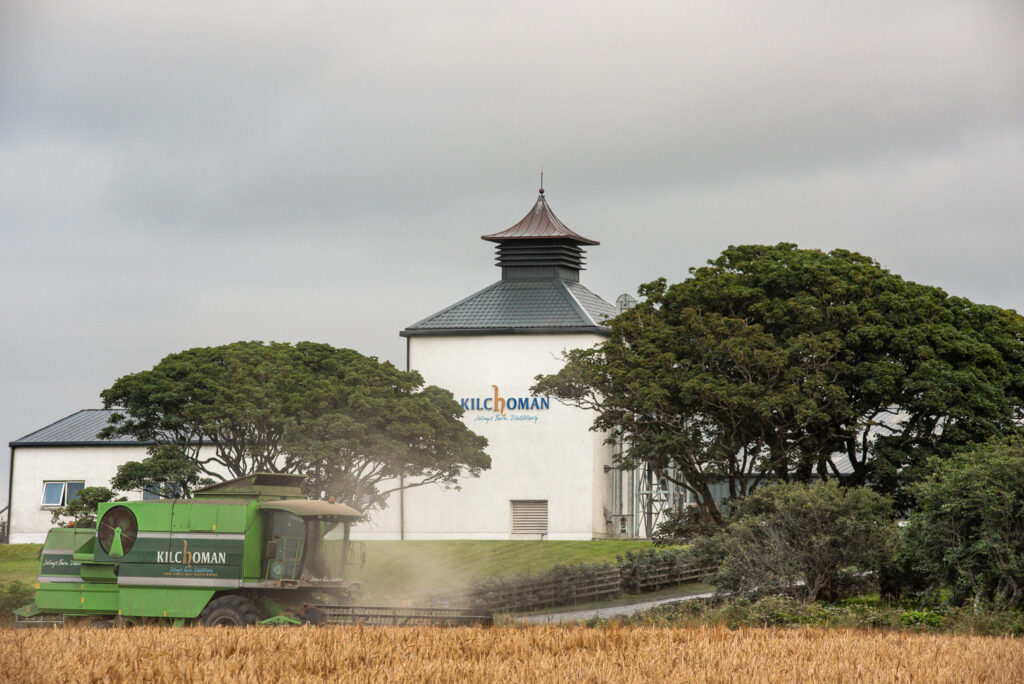
How you drink it
As scotch and bourbon are different drinks, they are often drunk in different ways. For starters, across the pond in America ‘on the rocks’ is a fairly common term, but not something you would often hear in the bars on Islay. By adding ice, you reduce the temperature of the Scotch and risk losing the flavours that it has to offer. On the other hand, ice has been known to actually enhance the taste of some bourbons. We would recommend drinking your dram of Kilchoman neat or with a splash of water and although typically not used for making cocktails, the team at Gleneagles Hotel have created some amazing Kilchoman based cocktails!
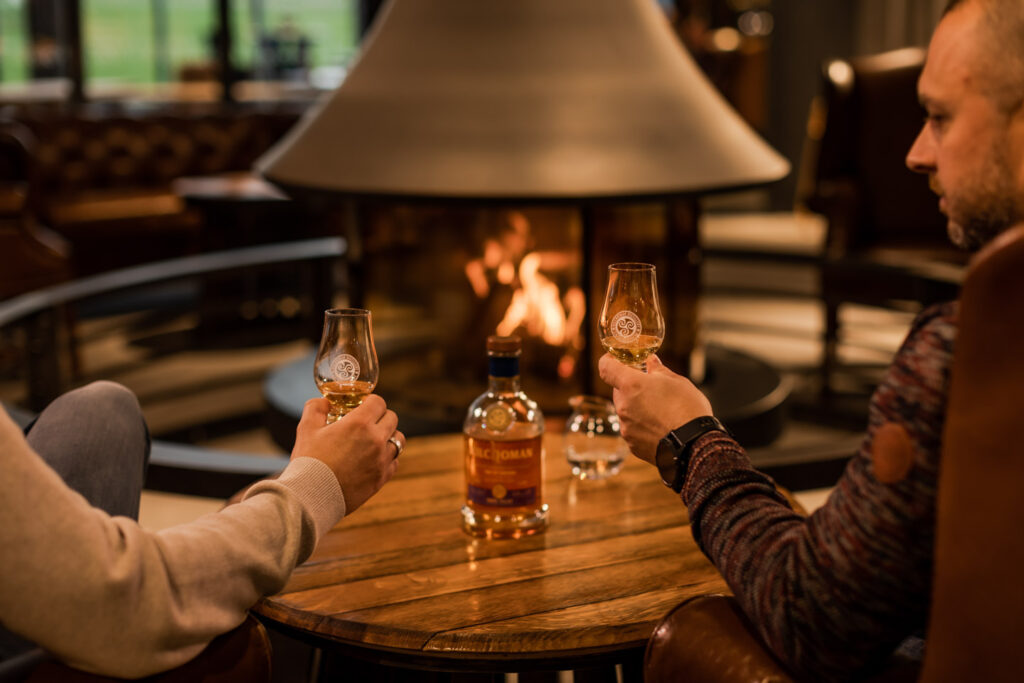
Taste
This is arguably the most important difference of all, as it is the flavour of whisky that takes so long to perfect. What sets scotch whisky apart is the range of tastes and aromas that vary hugely from distillery to distillery and region to region, as we pointed out in our article on the regions of Scottish whisky. While a scotch from Speyside is known for its nutty and fruity tang, a triple distilled malt from the Lowlands may offer notes of grass, cinnamon and ginger. Kilchoman is made on the island of Islay, so with our whisky you can expect layers of smoky aromas and rich peat flavours.
Bourbons can also have a hint of smoke but are characterised primarily by their often sweet flavour. This sweetness comes from the new charred-oak barrels that they are matured in. The wood sugars from the barrel slowly ooze into the whiskey while it matures, giving the bourbon its signature caramel flavour. Of course, not all bourbons taste the same, and this sweetness can come in the form of an array of interesting flavours such as vanilla, butterscotch or honey.
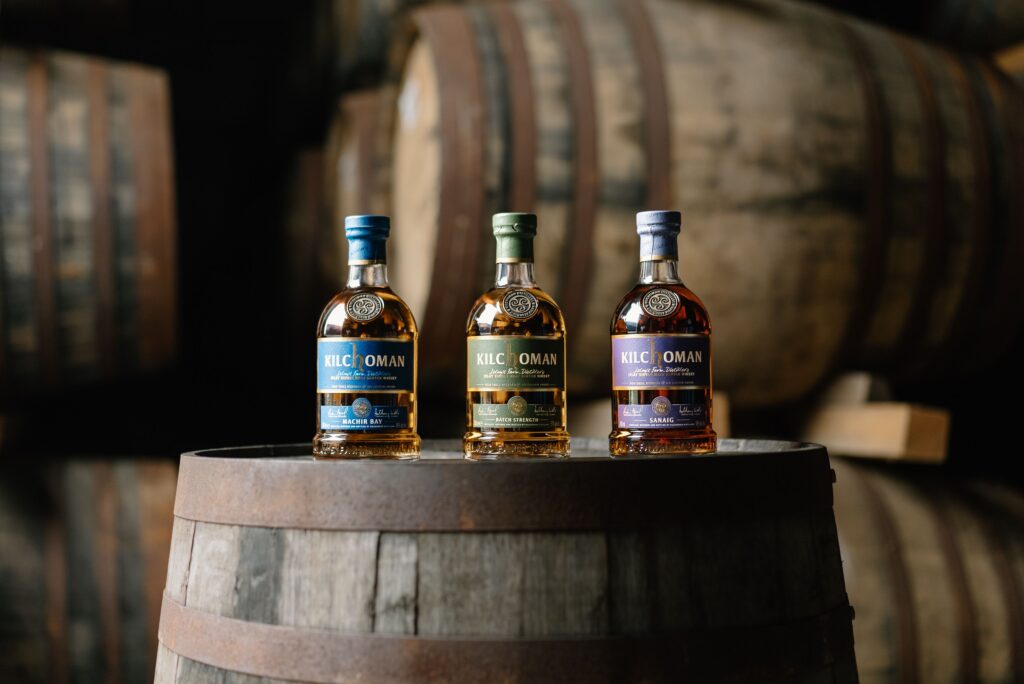
Hopefully we have been able to clear up some misconceptions surrounding scotch whisky and bourbon whiskey. The next time you hear someone say “all whisky is the same”, make sure to prove them wrong with your new found knowledge. Scotch and bourbon have their own unique characteristics, and it is important to appreciate them. While there is no definite answer to which of the two whiskies is the better drink, we certainly know which one we prefer!
To learn more about what we do at Kilchoman and our range of Islay Single Malt Scotch Whiskies, click here for the free sign-up to become a Club Member and keep up to date with all our distillery news and information about our news releases!
Islay’s distilleries each have their own unique history, vibrant layers woven deep into the fabric of the Island. If you’re lucky enough to ever find yourself stood on the golden sand of Machir bay on a rare sunny day, you might even detect the warm scent of peat smoke rolling over the sand dunes from Kilchoman’s Kiln. Follow that scent and you’ll walk past golden fields of barley, right up to the gates of the distillery itself. Unlike other whisky distilleries on Islay, that grain is the one that ends up in the bottle – forming our 100% Islay single malt whisky. In fact, every step of its production, from barley to bottle, takes place on-site. It’s the way whisky was meant to be made, and if you’d be so kind as to join us on the Kilchoman distillery tour, we’ll show you just how.
The Meet
After arriving at Kilchoman, you’ll get a chance to meet fellow tour goers and have a look around our visitors centre. Adorned with traditional low beams and mementos of life on Islay, it’s the perfect space to mingle and absorb some of our history before the main event begins.
The tour starts with an induction by one of our tour guides. With encyclopedic knowledge of the distillery’s inner workings, they’ll guide you through the history of Kilchoman; from the ambitious vision of founder Anthony Wills to the bottles of whisky being produced today and hear what the future holds for Kilchoman. As the smallest distillery on the island there’s a family feel to affairs, questions are encouraged, and anyone is welcome to photograph throughout the tour. In fact, there’s a good chance you might bump into Anthony himself, or his wife Kathy, or any of their three sons checking the production – all of whom have been known to happily stop for a chat. Like we said, it’s a family affair.
The Malt
Stop one of the tour is the malting floor. Here four tons of barley are soaked for 48 hours before being spread evenly across the malt floor. This step begins the germination process, where natural enzymes begin to break down the starches in the grain. As the grains are turned and raked by the production team, the sweet nutty aroma of the sugars are released into the surrounding air. Visitors are welcome to pick-up and feel the barley for themselves, noticing how it runs between the fingers and varies from grain to grain. It’s hard to imagine that whisky could ever be produced from these tiny seeds but soon the picture starts to come together.
The Kiln
Islay is famous for its peat, with its distilleries using the natural sources for centuries to produce peated single malts renowned the world over. The kiln at Kilchoman is no different, sitting our barley three metres above a gentle smoldering peat fire for 8 hours allowing the rich smoke to pass through the barley, before we then start to dry the barley – stopping germination at just the right point. The smoke from this fire is one part of what gives Kilchoman its unique, complex taste, quite literally absorbing the flavours of Islay.
The Mill
While looking around you’ll be able to see that all the equipment has been custom-made to produce the exact flavours desired by our stillmen. Every piece but the Mill that is. Used to expose the sugars from within the tough outer husk of the barley grains, the Porteus mill we use has been running consistently for eighty years, predating the distillery and all of those that work within it.
Over the continuous rumble you’ll be told the bittersweet story behind the mill, the constantly beating heart of the distillery. You’ll also be able to see how the barley ends up as grist, a mix of husk, grit and fine flour. You can actually use the grist to produce traditional scottish cakes, but more about those later.
The Mash
Our Still House is also home to our Mash Tun you’ll be able to witness the process used to extract the sugars from the grist, 1.2 tones to be precise, is put in to our small but perfectly formed mash tun. Here the sugars dissolve into hot water creating a naturally sweet, nectar-like water known as ‘wort’. You will also be told why there are bent spoons over the sprinklers… Some people describe drinking wort like eating raw cake batter, some quite enjoy a sample but we prefer it as whisky. Of course, you can judge for yourself and you’re more than welcome to try some, comparing it to the wash created in the next step. Speaking of…
The Fermenting
As you enter our Tun Room you will see our 6 wash backs. These contain cooled down wort and just the right amount of yeast to break down the sugars within, producing the all important alcohol and carbon dioxide. This might sound familiar to some. We call it ‘wash’ but others will know it better as beer, a strong one admittedly (8%), that you can sample fresh from the production line.
Not only are Kilchoman wash backs smaller than the other distilleries on Islay, they also keep the wash inside for around a day longer than most other distilleries, 82 hours in total. This extra time is what gives Kilchoman its light, fruity and slightly dryer wash which once distilled produces our unique floral and sweet spirit.
The Distillation
If the mill is the heart of distillery then the two pot stills we use are its hands, taking the wash and carefully moulding it into the pure Kilchoman spirit. You’ll be able to examine both the wash still, used to produce 1000 litres of 19% ‘low wines’, and the spirit still, which refines this further into 300 litres of pure spirit.
Each distillation lasts around three and a half hours, during which the production team makes sure only the ‘heart’ of the spirit ends up being sealed into our selected casks. The science of pot stills is incredibly intricate, and our spirit still has been hand-crafted to make the most of it. Our stills are the smallest on Islay and amongst the smallest throughout the whole of Scotland. This, alongside an elegant copper neck and reflux bulb, helps to achieve the distinct character Anthony Wills set out to achieve almost 13 years ago.
The Maturation
For the keen whisky enthusiast on the premium tour, you’ll be welcomed into the warehouse – where the spirit spends years interacting with the oak casks that give the whisky its depth of flavour. No cask is the same as the last and our expert team are on hand to share their secrets, as well as a dram or two.
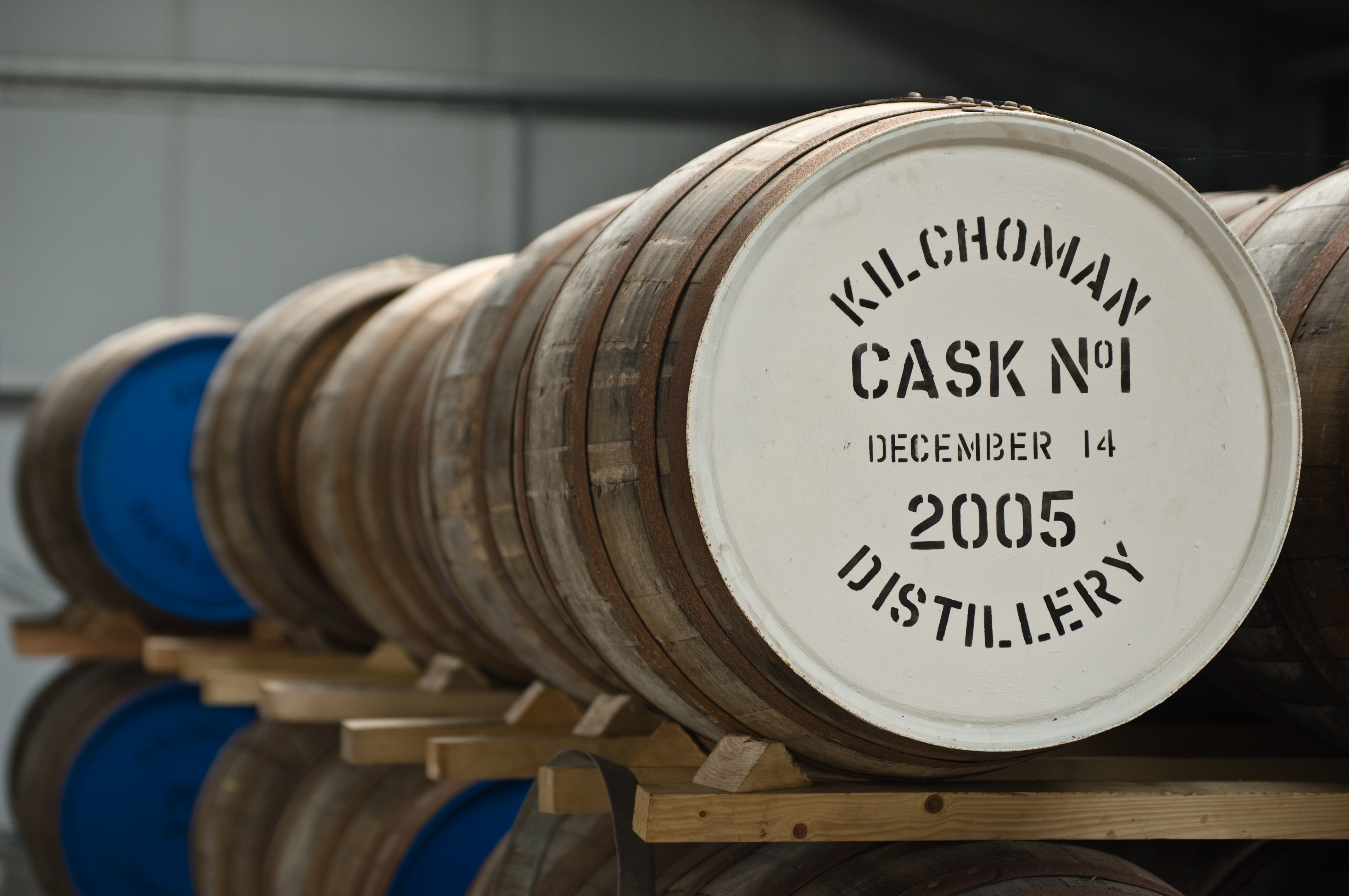
The Bottling
We are one of only two distilleries to bottle our whisky on Islay and at the distillery. In the Bottling Hall you’ll find our hard-working team, taking care to bottle and seal each bottle, before finally adding the kilchoman coin. Over recent years the bottling hall has been expanded to keep up with the increasing demand for our range of Single Malts. Although all our single cask releases are still hand labelled and numbered.
The Taste
What’s a whisky tour without a taste? During the tasting session you’ll be able to compare notes with other members and your guide, raising a dram unlike any other. For those unlucky enough to be designated drivers (or who just don’t fancy it) you also have the option of taking your samples home as a miniature, perfect for sampling later.
For those on the premium tour there’s a longer tasting session of five drams in total. Between each sample the palette is cleansed with a homemade grist biscuit (told you they’d return) and a discussion of the flavours that form each sample. Every member of every tour is also welcome to keep a branded Kilchoman tasting glass as a souvenir, lovingly boxed for safe transit – though why you’d want to leave is another matter.
The Finish
Smooth and with a warm afterglow, but enough about the whisky. After your tour has come to a close you’re welcome to come have a chat with anyone here at the distillery, learning about all that makes Islay so much more than the whisky we make. You can also have a look around the Kilchoman shop, everything from whiskies to traditional Scottish tweeds – designed by Kathy Wills. It’s a family affair and we’d love it if you joined.
After one of the best summers for decades, the days are shortening and the wind and rain have returned. The barley farmers on the mainland have long since packed away their combines, here on Islay it’s a slightly different story. The late sowing of our barley, 6-8 weeks behind farmers on the mainland means we’ve missed the better weather for harvest and we’re now battling the autumnal weather to get the barley off the fields.
Single Variety
This year we planted a total of 97.5 acres. After trialing a new barley variety called Laureate last year, we decided to sow 77.5 acres of Concerto, a variety that we know from experience does well on Islay, and 20 acres of Octavia, a variety that we had not grown before.
It would appear that the Concerto has faired slightly better than Octavia. The Concerto ear (the barley head which holds the grains) is notably bigger, the grains bolder and there are more grains per ear, on average 28 against 22 for Octavia. This will likely mean that the Concerto barley will provide a higher yield (tonnes per acre) than the Octavia but only time will tell.
Barley varieties aside, this year we are doing things a little differently. Once harvested, in the past, all our barley (no-matter what variety) has been harvested and dried together before being malted and distilled jointly. This year the Concerto and Octavia varieties will be harvested and dried separately, before being individually malted, distilled and matured eventually becoming…
…Islay’s only Single Variety, Single Farm, Scotch Whisky…
 From left to right, Concerto and Octavia
From left to right, Concerto and Octavia
Single Farm
Whisky enthusiasts have often speculated about the extent to which barley varieties influence the character of single malt and with recent improvements to our malt house, we will be able to give some answers.
The thing that will make this interesting is that this will be the first opportunity to isolate barley variety and how it alone impacts the character of the whisky. Other comparisons of varieties and their impact on single malt have been open to variances in growing, malting, distilling and maturation. As we have control over each aspect of production on a Single Farm, from grain to glass, everything apart from barley variety, will be identical; from growing the barley in neighboring fields, malting on the same malt floor, distilling in the same stills and maturing in the same casks in a single warehouse.
All being well, we should finish harvesting by the end of the week and come January we will begin malting and distilling the first batches of Concerto and Octavia barley, at which point we will update you on the initial findings.
Anthony Wills, Kilchoman Founder and MD “We’re excited to see how this project turns out. We fully expect there to be a difference between the varieties however the extent and particular character created by the different varieties will be very interesting to see. I look forward to tasting the spirit early next year.”
It’s not an exaggeration to say that Scotland is quite literally the greatest country in the world. It’s the birthplace of Robert Burns, Alexander Graham Bell, William Wallace and even Obi-Wan Kenobi. It’s the country that’s given us Dolly the sheep, penicillin and the world cup before the world cup was even a thing.
However, Scotland isn’t simply a singular mass of greatness. No, think of it as a collection of many incredible locations, each rich with their own identity, history, culture and traditions. Nowhere is this more evident than in the whiskies we produce. They say the only way to understand a place is to first understand its whisky.
Highlands
As the name suggests, this region is high – geographically and in terms of altitude. It’s also the largest area of the whisky producing regions, with most of its distilleries dotted around the coast, away from the mountains that dominate its landscape. Although treated as a single entity here, it’s possible to spend hours dissecting the map further and further into increasingly smaller areas, all with their own unique whisky profiles.
What brings together all highland whiskies are their shared history; a history linked to the Anglo-French war of 1778 to be precise. See, the English had it in for the French for a while, diverting tax revenue to help fund Britannia and her wave-ruling activities. As a result, they suddenly decided that the Scots should be paying the same taxes on malted barley and distillery capacity as they did in the south.
Well, that is unless you lived in the Highlands, in which case you could still produce whisky at the lower rate of duty. This, of course, was all on the proviso that you only used local barley, limited yourself to one small still and drank the product within the confines of the local district.
The grand result was a separation of whisky culture. The low-paying Highlands were creating quality small-batch whiskies, and the high-paying Lowlands began to export whisky to the masses. This legacy has continued with Highland whiskies known for their variety of flavours wrapped up amongst dark and earthy colours.
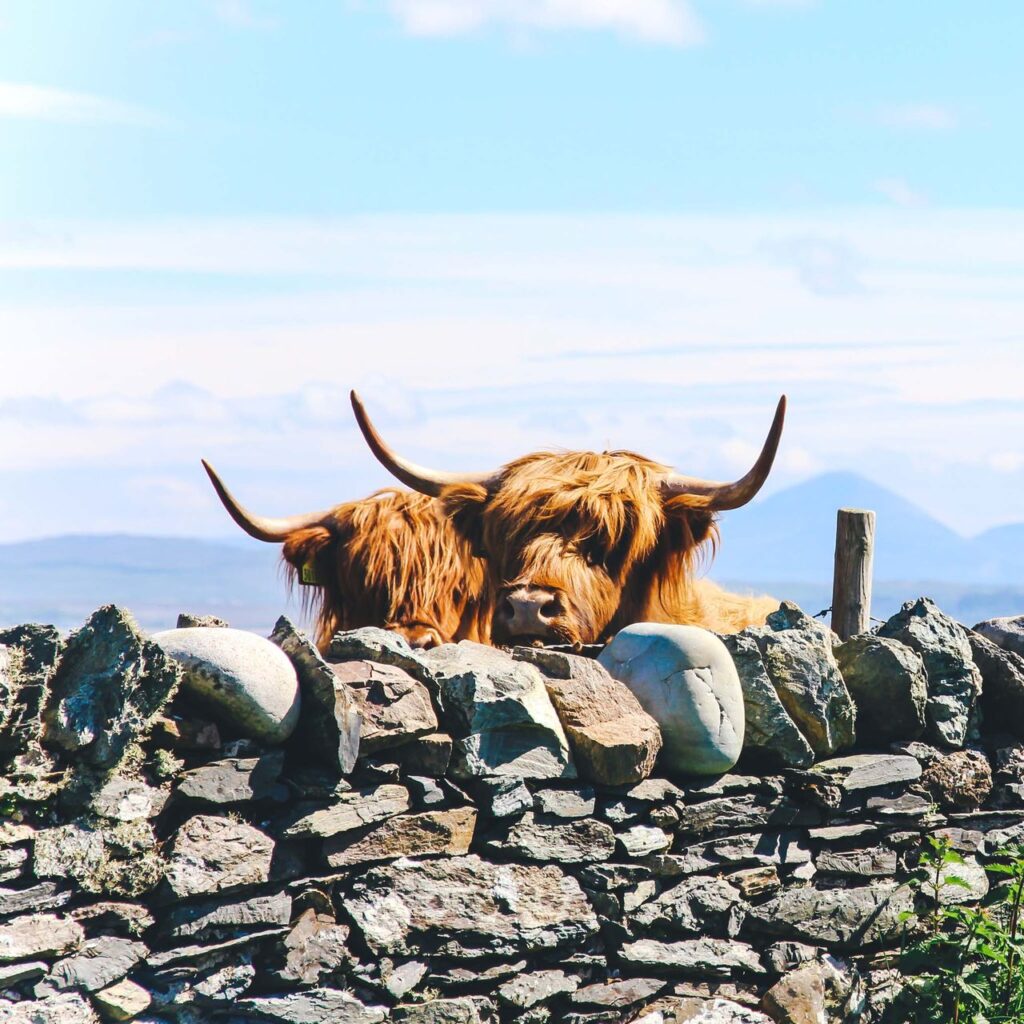
Lowlands
The Lowlands, an area of land between the North of England and the edge of the Highlands, have surprisingly few distilleries given the number of people living there and when you consider the fact it contains Glasgow and Edinburgh. As mentioned, this was largely due to the heinous tax system levied by parliament in the 18th Century.
However, a decision on whisky tax was approved by parliament in 1823, resulting in a massive decrease in the amount of excise duty paid on Lowland whisky.
Although it has taken some time to fully recover, the lush green fields and positively balmy climate make the Lowlands an ideal region for growing barley. This gives rise to distilleries that produce a gentler whisky than their highland counterparts, using little or no peat in production as well as a history in triple distillation. These single malts are known for being fresh, light and floral.
Speyside
If you imagine the outline of Scotland as a gaping silhouette of a hungry bird, then Speyside is its tongue – nestled in its own corner of the country. Named after the river Spey, it’s sometimes mistaken as part of the Highlands, yet its whiskies make it a very different beast indeed.
Half of Scotland’s single-malt distilleries are found in Speyside, the most densely populated whisky region in the world. The low mineral content of the Spey shaped the style and character of the whiskies in the region, although with so many single malt distilleries it is difficult to categorise all its whiskies under one umbrella.
That said, there is a ‘traditional’ Speyside character found in most of its whiskies – one which results from centuries of shared ideals in the area. These are the classic sweet flavours of honey and vanilla, as well apple and/or pear. Furthermore, a majority of Speyside whiskies are still aged in sherry casks as was the tradition, hence the often sweeter flavour profile.
Campbeltown
Nestled cosily between the isle of Arran and Islay, Campbeltown used to be home to no less than 34 scotch whisky distilleries. Nowadays, though, its number has shrunk to three. This is namely because improved transport links with the Highlands and Speyside made its goods less attractive for export in the late 1800s. Still, as we know well at Kilchoman, it’s not about how much whisky you make, it’s about what you do with it. Here, Campbeltown does not disappoint and the remaining whiskies have stuck to their roots and produce in their own style.
The Islands
It’s important to note that the disparate Scottish islands of Arran, Jura, Mull, Orkney and Skye (or the Inner Hebrides, as they’re also known) each have their own distinct scotch whiskies, formed from years of isolated tradition. However, the rocky shores and whipped ocean spray work to influence all the whiskies produced on these stunning outcrops, creating peated and unpeated whisky with authentic charm. Summed up, the island whiskies may be very different, but they all hark back to the sea. Each combines a range of caramel tones with a slightly salty undercurrent that brings a taste of the shore to your glass.
Islay
Now we come on to the main event, without being too biased of course. Although it’s technically the southernmost island of the Inner Hebrides, the isle of Islay is quite rightly considered a whisky region all on its own. Famous for its rich whisky pedigree, it’s thought that the first whisky borne out of these picturesque shores was distilled by Irish monks in the 14th century. Since then whisky has captivated the island and become the life and soul of Islay, with one feature helping Islay whiskies stand out from the rest – peat!
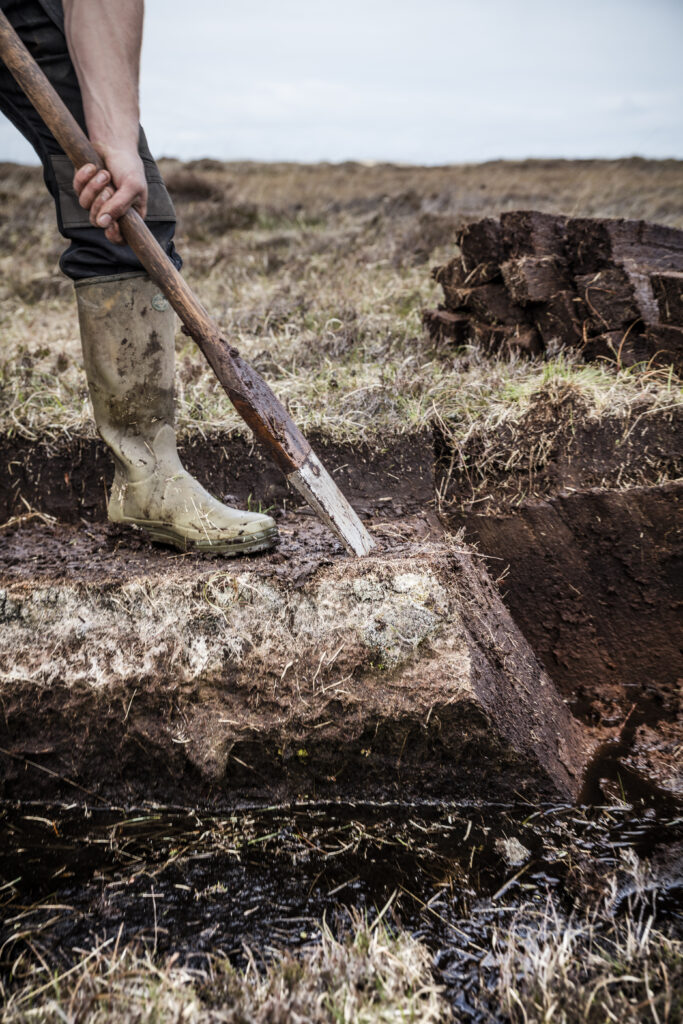
The climate of Islay means that it’s covered with characteristic peat bogs. These thick bogs provided the fuel used to dry our malted barley for milling, mashing and distilling. The impact this has on the malt is a fantastic smoky character which works its way into the core of Islay whiskies. It’s this distinct history and character that we at Kilchoman have tried to capture and distil into every glass of single malt we produce. Being the only Single Farm scotch whisky distillery on Islay that still carries out every stage of production – from growing the barley on the farm to bottling on site, we want to use all Islay has to offer.
Of course, there will always be disagreements over what is and isn’t defined as a region. And to be frank, we don’t really care. In our eyes there’s only one region (apart from Islay of course) that matters: a place that forms the lifeblood of civilised culture. A place that Obi-Wan is proud to call home. So raise a dram to Scotland, quite literally the greatest country in the world.
The first cask of Kilchoman, a refill bourbon barrel sourced from Speyside cooperage, was filled on December 14th 2005, a proud moment for everyone involved in the creation of Kilchoman. Thirteen years on from filling our first cask and we have substantially increased both the quantity and variety of casks in our warehouses. Whilst bourbon and sherry casks remain our two most frequently filled cask types, accounting for roughly 70% and 20% of our fillings respectively, we now have over 20 different varieties of cask maturing Kilchoman spirit here on Islay.
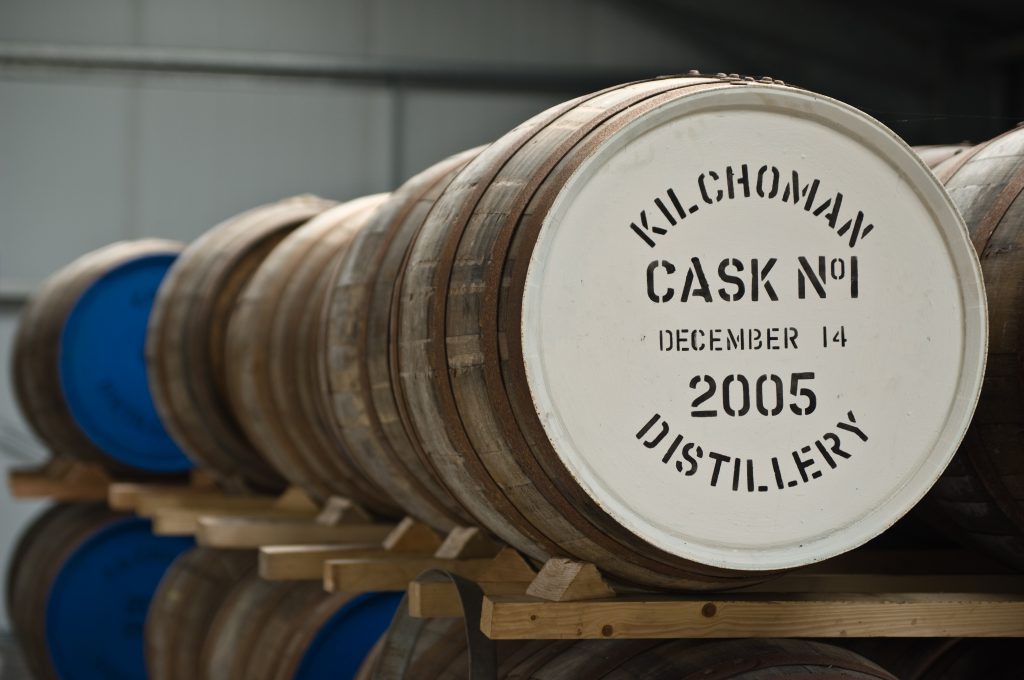
Bourbon Barrels
Like many distilleries, much of our new make (unmatured whisky) is filled into ex-bourbon barrels from the US. However, unlike virtually all distilleries we source our barrels from a single supplier and ship them whole directly to the distillery.
All our fresh bourbon barrels start their lives at Buffalo Trace Distillery in Kentucky, USA where they were first constructed before being used to mature their range of Kentucky Bourbon. Ade from virgin American oak, the barrels have a particularly deep char which allows for increased wood extract, crucial to both the character for Buffalo Trace and Kilchoman. Once the good folk in Kentucky have used them (just once by law) they are rolled onto a container and shipped to Islay, arriving about 8 weeks later with many barrels still containing a swill or two of bourbon. This wet cask shipping ensures the bourbon remains sealed within the wood and gives the Kilchoman maturation a kick-start, one of the key reasons our malts are so full of character at a relatively young age.
In contrast to our system for shipping casks whole and wet, most Scotch whisky distillers prefer to source their bourbon barrels from a broker. These companies buy barrels from multiple US producers and deal in the shipping and reselling of these barrels in Scotland. This usually entails breaking down the barrels when they are shipped to minimise costs which often means the barrels dry out, resulting in much of the character held within the oak being lost.
The light caramel, vanilla and fresh fruit character imparted by the Buffalo Trace barrels pairs beautifully with the citrus, tropical fruit and maritime peat smoke of our spirit and continues to be the principal part of our flagship bottling, Machir Bay.
Sherry Casks
Our principal sherry casks of choice are oloroso sherry butts, sourced from Bodegas José y Miguel Martin in Jerez, Spain, these 500ltr monster casks form the second largest segment of our maturing stock. In contrast to the light influence of bourbon barrels, oloroso sherry butts add layers of bold spicy, rich character to the whisky. As with our bourbon barrels, the sherry casks are shipped directly to Islay and filled whilst the oak is still soaked in sherry. The 2018 Loch Gorm, our annually released limited edition is a vatting of nineteen oloroso sherry butts filled in 2007, 2008 and 2011. It’s all sherry maturation gives it a distinct combination of bbq smoke and sweetness balanced with light fruit and rich peat smoke, which sets it apart in our range.
As well as oloroso butts and hogsheads (smaller 250ltr oloroso sherry casks) we also use fino and Pedro Ximénez sherry casks, the fino’s adding layers of green apple and white grapes, the Pedro Ximénez’s imparting waves of dried fruit, toffee and PX sweetness.
Multi-Cask Vattings
As well as single cask maturation we will often combine multiple cask types, as with the Machir Bay and Sanaig releases, to create a balance of sherry and bourbon influence. Much like a chef (or magician), Anthony Wills, our founder, will combine the lighter bourbon matured spirit with some richer sherry maturation to create a particular style of Kilchoman, balancing the attributes of each cask type.
Experimental Casks
In addition to our core stock of bourbon and sherry casks, we fill a range of casks including numerous varieties of port, wine, cognac, madeira and rum, each earmarked for future single cask or limited edition bottlings. In contrast to most distillers who use these cask types for short periods of ‘finishing’ at the end of maturation, we prefer a full term maturation; filling the casks with new make spirit to allow the full influence of the cask to impact on the whisky. This can be a risky strategy as these cask types are renowned for imparting bold and powerful flavours, however our Port Cask Matured, released in Spring this year, proves the benefits of full term maturation, creating a unique bottling which combines and balances all of our characteristic peat smoke and citrus with raspberry, cherry and creamy vanilla influence of the Ruby port casks.
Anthony Wills, our founder, on the overview of Kilchoman casks, ‘I was keen to experiment with other cask types for full maturation and we have successfully filled and released expressions matured in Madeira, Port, Sauternes and Red Wine casks. We have recently filled Cognac, rum and calvados casks and I continue to look for other cask types to fill. We use the casks as fresh and refill, then sell them on’.
We continue to lay down stock for future age statement releases as well as experiment with new cask types, follow us on our social media channels or join the Kilchoman Club to keep up with all the goings on.
Kilchoman Comraich is a global network of bars dedicated to the enjoyment of Kilchoman single malt. Here you will find the finest and widest range of Kilchoman single malts, including special Comraich bottlings exclusively available from Comraich sanctuaries.
The ruined Kilchoman Church stands proudly beneath the cliffs of Creag Mhór, half a mile west of the distillery. Chief amongst its artefacts are Sanctuary stones dating back to the 800s. Such sanctuary stones were common place in medieval times, marking
an area of ‘Comraich’ or sanctuary in the local Gaelic language, safe from harassment and arrest.
Kilchoman Comraichs are a collection of sanctuaries, sheltered from the commotion of the outside world, dedicated to the enjoyment of Kilchoman Single Malt. Kilchoman Comraich establishments serve as bastions of Kilchoman with exclusive access to the Kilchoman Comraich batches. These will be available solely from the Comraichs along with a wide range of other Kilchoman bottlings.
Batch No.1 of the Kilchoman Comraich series is a vatting of 2007 oloroso sherry butts and bourbon barrels selected by Anthony Wills, Kilchoman Founder. The combination of cask types allows for a unique marriage of rich, sherry influence and light citrus and vanilla character from the bourbon barrels.
Comraich bars have already begun to launch around the world and the locations will soon be available on our new website in June! Keep an eye out…
The weather for this year’s harvest was very unsettled and we were delayed by over two weeks before we could get our new combine into the fields. We eventually started on the 17th September, we combined for 2 days and managed to get over half of the barley in before the weather changed. It wasn’t until the 25th September that we managed to get back out and the Farm team worked to the early hours to finish the harvest. Working late turned out to be a great decision, as other farmers on Islay are still struggling to finish their harvest. We harvested a total of 204 tonnes with yields of 1.9tonnes an acre. If we had managed to get on to the fields earlier when it was ready we would have achieved higher yields, as we had barley flattened by the wind and rain which made combining a lot harder.
Tweet Widget
2017 has been another successful year for Kilchoman at the IWSC* awards, whilst we didn’t quite surpass last year’s NAS* WHISKY OF THE YEAR trophy for Sanaig, we were delighted that Machir Bay, 100% Islay and Loch Gorm were all recognised. 100% Islay 7th Edition won Silver Outstanding while Loch Gorm 2017 and Machir Bay both picked up Silver Medals. Find out more about 100% Islay, Machir Bay and Loch Gorm by following the links. 100% Islay 7th Edition and Loch Gorm 2017 are sold out on our website but you should be able to down a bottle if you get in touch with your local whisky shop.
*International Wine and Spirits Competition. *No Age Statement.

